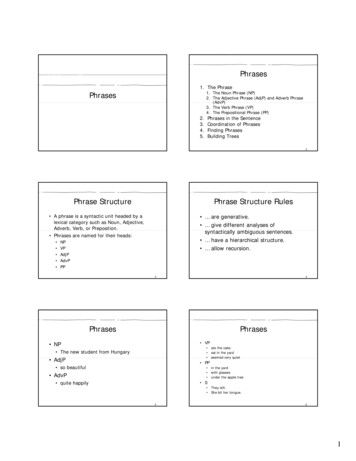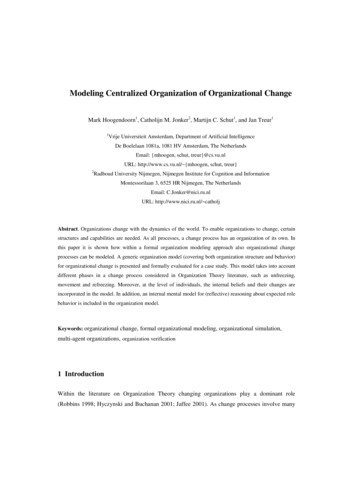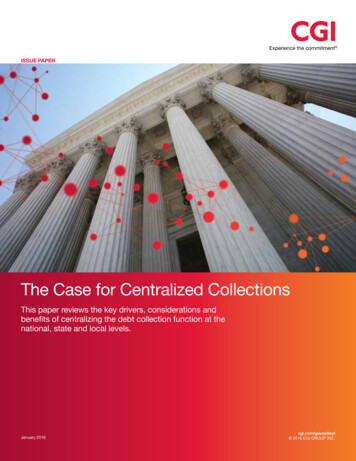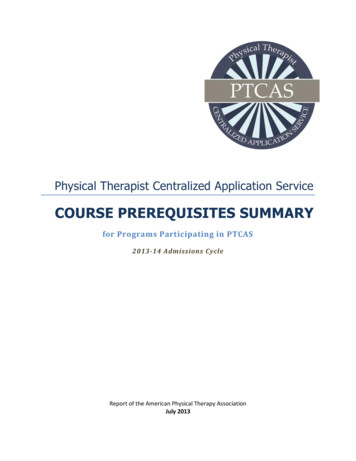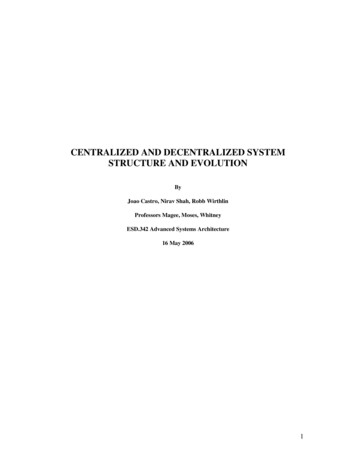
Transcription
CENTRALIZED AND DECENTRALIZED SYSTEMSTRUCTURE AND EVOLUTIONByJoao Castro, Nirav Shah, Robb WirthlinProfessors Magee, Moses, WhitneyESD.342 Advanced Systems Architecture16 May 20061
INTRODUCTIONThere are many kinds of systems that exhibit similar properties, but have hidden underpinningsthat fundamentally differ the way they operate. The purpose of this project is to attempt to learn somethingfundamental about the structure of systems and the structure of the organization that controls or developsthem. When a task is too complex to be carried out by a single person, a team, company or organization isput in place in order to, collaboratively, carry it out. These groups establish rules and procedures in aformal or informal way. Besides the skills of its members, the structure of an organization has a greatimpact on the success it has.Our hypothesis is that systems that are structured or centrally designed are different than those thatare unstructured or emerge in an evolutionary fashion.Our approach to analyze this issue was to observe transportation networks and knowledgenetworks using network analysis tools and compare results to determine if any specific behavior emerged.We focused on systems that are a result of centralized and decentralized organizations in two verydifferent categories: knowledge and transportation. This was done to allow us to compare and controlresults in the comparison that are only characteristic of a single category.Knowledge networks are established by the relationships between different topics of factualrecord, interest or research. Encyclopedias are an example of this, since they try to map out as much of theknowledge space as possible for reference by readers. In this work we studied in detail the EncyclopediaBritannica and the Wikipedia. We also did some research on other potential sources for this category, suchas Encyclopedia Britannica online, Mathworld and Encarta [1].The following table summarizes some of the key aspects of all these systems and orsStability (rateof change)EncyclopediaBritannica2001199517681 million12527 articles 31,550 pages inarticles, 34032 volumesmillion words65,000 articles1 millionHighMathworldOnline E. B.Encarta199341000 articles, standard68000 articles, premium1Med1994120,000articles, 55million words;CD-ROM4000Medium4000Yearly annualupdate editionNot availableMediumAccessibilityPeer ReviewFreeFreePurchaseMemberships MembershipsLittle;YesYesYesYesbecoming morefrequentEase of change EasyChangesHardHardChanges solicited;solicited;reviewed; no creditreviewed;givencredit givenShallowMixedDeepMixedMixedDepth of“knowledge”(Macropedia)Table 1: List of various information networks [1]2
Transportations networks have become integral parts of the public transit infrastructure of almostevery major industrialized city in the world. Broadly speaking, the systems can be thought of as a set ofinterconnected networks providing different modes of transportation to the inhabitants of city. Forexample, in Boston, the city consists of a subway, commuter rail, busses and commuter boats and ferries.The focus of this study is the subway or ‘metro’ portion of larger multi-mode network. A typical subwaynetwork consists of several stations distributed throughout an urban area connected by a network of lines.To qualify as subway these lines should be located underground. Many systems however have aboveground (e.g. green line in Boston) and elevated portions as well. For the purposes of this paper, systemsthat are largely underground are considered subways. Data was gathered in the forms maps of the subwaysystems. We studied six networks with the following properties:London [2]Beijing [3]Year Started18631965Number of Stations275138km of track415197.7Planned vs. EvolvedEvolvedPlannedBoston [4]1897120101.5EvolvedBerlin [3, 5]Moscow [6]Tokyo 0PlannedTable 2: Transportation networks [3, 6-9]For both types of system we found examples of centralized and decentralized organizationsrunning behind products in that category as illustrated by the ralizedEnc. BrittanicaWikipediaBeijingMoscowLondonBostonFigure 1: Definition of project spaceFor purposes of clarity, this paper will discuss each type of system individually, rather than in acombined fashion.WIKIPEDIAI. System descriptionsWikipedia [10],[11] is an online encyclopedia that is freely accessible to consult and edit, witheditions in several languages. The most popular editions are English, German and French. Contributions tothe Wikipedia are generally unrestricted, with users allowed to add and change any article, as best as they3
see fit. No user is ever given ownership on any of the content of the encyclopedia so future improvementsare possible and most material deposited in it is considered public domain.A. Stimulus, main actors, stakeholders / System Extent (boundary and quantities)The Wikipedia body of knowledge is built through the effort of many different people whocontribute to the several editions as volunteers.A comparison of the most popular editions is made in the table below:EditionEnDeFrPlJaSvItNlPtEs# Edits 5195316393532721590# Admins[12]4961555548Internet# Articles [12]# Users [12]users 32.0M963491021304045.2MTable 3: Wikipedia language edition 824968214063113The Wikipedia software and servers are maintained by the Wikimedia non-profit corporation [1].Besides having open-content, Wikipedia runs on open-source software, effectively allowing anyone tostudy how it works and improve upon it for their own needs. Besides all the raw data, reasonabledocumentation on the structure of the system and the information is provided. The following illustrationshows the technical architecture of machines used to store and display the information to users onlinethrough a mix of database, backup, web, search and proxy servers.Figure 2: Wikipedia Technical Architecture [15]4
B. Sources of Needs and RequirementsWikipedia is bound only by the imaginative inputs of its unknown users and their ability to writedown their thoughts. It has also been responsive to the desires of many users who have created “watchlists” to articles of interest to them, possibly to track updates, discussions, and vandalism [1].C. System extent (Boundary and Quantities)Wikipedia is argued by some to have no boundaries. However, some boundaries exist through the‘self-policing’ that users provide, as well as the boundaries offered by the laws of science (it isn’t selfaware or alive). If something is wrong in an article, someone will often correct it soon thereafter[1]. Ofcourse, this is often a matter of opinion. Additionally, Wikipedia has 229 language editions of which 132of them are considered “active” [1].D. Mission statements, explicit if it exists or “reasonably presumed” for purposes of projectWikipedia proclaims that it is the “free encyclopedia that anyone can edit”[1].II. System historical background and evolutionA. History of each version fieldedThe simple study of a Wikipedia dump already allows us to see a lot of the historical activity andevolution of the product. A different historical perspective on Wikipedia is to analyze its popularity andgrowth as a respected reference and by the number of registered users through time.6000050000400003000020000100000nJa01 0 1 002 00 2 002 00 2 003 00 3 003 00 3 004 00 4 004 00 4 005 00 5 005 00501 0 12 r220 r 20 l 2 0 t 20l2t 2 n 2 pr 2 ul 2 ct 2 n 2 pr 2 ul 2 ct 2 n 2 pr 2 ul 2 ct 2nJJJJu Oc JaJu Oc Ja ApOAJaOJaOAAApFigures 3 & 4: Traffic evolution on wikipedia.org [14] and Evolution of registered users onthe Wikipedia English editionB. Important changes in system architectural structure, defined by methods we have been discussingWikipedia has not had any remarkable changes in its architectural structure except in the hardwareinfrastructure that has hosted the material. It is built upon a scalable architecture. Please see Figure 2above for the most recent structure layout.C. Its size, scale, network metrics or other descriptors over time as possibleWikipedia has a set of database files regularly copied and stored for each of the language editions.These “dumps” are publicly available at download.wikipedia.org website [12].The English edition of Wikipedia has grown very fast, having achieved over one million articles5
and the supporting files are very large. Its dump generates a compressed file over 4GB which,uncompressed, uses 452GB of disk space, making it harder to analyze without high-end resources.Language editionEnglishPortugueseSimple table2006-03-031002326255 MB1.5 GB2006-03-0111858920 MB114 MB2006-03-0276331.3 MB8.5 MB6.74 MBTable 4: Data about various language versions of Wikipedia [12]Texttable224 MBThe information held in Wikipedia is extensible in as much as its markup language evolves. Forexample, the current version does not include math operations although there are independent partiesstarting to explore this possibility. Once mature, this technology should be easily incorporated intoWikipedia, demonstrating its extensibility.III. Assessment of system effectiveness over time including current critical issuesWikipedia has been very successful. Its growth and adoption by internet users follows a patternsimilar to first-to-market trends and continues with the so called “Matthew Effect” (e.g. the rich get richer).Google, whose algorithms are based upon prestige, usually offers a page from Wikipedia near the top ofmost search results [16].A. Related to system characteristics like flexibility, complexity, robustness, cost, performance, etc.As a system, Wikipedia exhibits some of the esteemed ilities:The software tool is the key responsible for the flexibility of the content to be changed by anyuser, registered or not. This flexibility is also tied to resilience/repairability because any damaging changecan be easily reverted.Wikipedia demonstrates robustness, not in the software layer, but in its community of over onemillion users. When a user detects an error he can immediately change it. If there are issues that can’t besolved immediately, users can talk to each other to solve disputes.Finally, there are some damaging edits (erasing, defacing, and smearing) that happen in thesystem. Some users specialize in detecting these unwanted and unusual edits or users doing them andcorrect the actions of these rogue “vandals” as they are know in that community [1].In terms of quality, since Wikipedia tries to describe the entire body of human knowledge, thisaspect is hard to determine. Anyhow, Wikipedia has been favorably compared to the standard EncyclopediaBritannica and generally regarded as having similar quality [17].The multi-language support can be regarded as a modularity attribute.ENCYCLOPAEDIA BRITANNICAI. System descriptionsThe Encyclopaedia Britannica is widely recognized as the first modern encyclopedia and has beenin publication for almost 240 years [18].6
A. Stimulus, main actors, stakeholders / System Extent (boundary and quantities)The Encyclopaedia Britannica is recognized as having a centralized approach to knowledge. Thecurrent operation of the Encyclopaedia Britannica consists of a corporate board with a board of editors.“Headquartered in Chicago, Encyclopædia Britannica, Inc. is also located in Delhi, London, Paris, Seoul,Sydney, Taipei, Tel Aviv, and Tokyo, and has already produced a variety of works in 12 languagesalongside English” [19]. These editors are responsible for the overall content of the EB. In turn, there areover 4000 individual contributors to the material that makes up the EB. The contributors are usuallyrecognized scholars in their respective fields and also considered very knowledgeable about the subjectthey are writing about. “The men and women of Britannica's Editorial Board of Advisors—the Nobellaureates and Pulitzer Prize winners, the leading scholars, writers, artists, public servants, and activists[who] are at the top of their fields. They meet regularly to share ideas, to debate, and to argue, in a uniquecollegium whose purpose is to understand today's world so that the resulting encyclopedia can be the bestthere is” [20]. After an article is written, the material goes through an internal peer review process, duringwhich time the material is heavily scrutinized. Once accepted by the peer review process, the material isaccepted for publication in the EB [21].B. Sources of Needs and RequirementsEach year the EB is subject to review and possible revision. Exactly which articles are chosen forthe update is not known. However, there is also a huge effort to publish the “Book of the Year” – acollection of articles and other materials that give a synopsis of the major events (newsworthy andscholarly) that occurred during the previous year [18]. Portions, or perhaps all, of this material isincorporated in the next printing of the EB. Additionally, all new material must be designated for inclusionin various areas of the EB: the Propaedia, the Micropaedia, the Macropaedia, or the Index (more discussionon these later). A reasonable supposition is that material is added, updated, or removed from the EB,depending upon its apparent impact upon the EB’s Circle of Knowledge – a formal hierarchy ofcategorization. Additionally, in this current edition, the 15th, it has undergone major revisions at leasttwice: first in 1985 and then in 2005 [18].The online version of EB, called Britannica online, was first introduced in 1994 [22]. There areseveral models of information access: a CD-ROM version (for purchase); a DVD version (for purchase);a
CENTRALIZED AND DECENTRALIZED SYSTEM STRUCTURE AND EVOLUTION By Joao Castro, Nirav Shah, Robb Wirthlin Professors Magee, Moses, Whitney ESD.342 Advanced Systems Architecture 16 May 2006 1. INTRODUCTION There are many kinds of systems that exhibit similar properties, but have hidden underpinnings that fundamentally differ the way they operate. The purpose of this project


